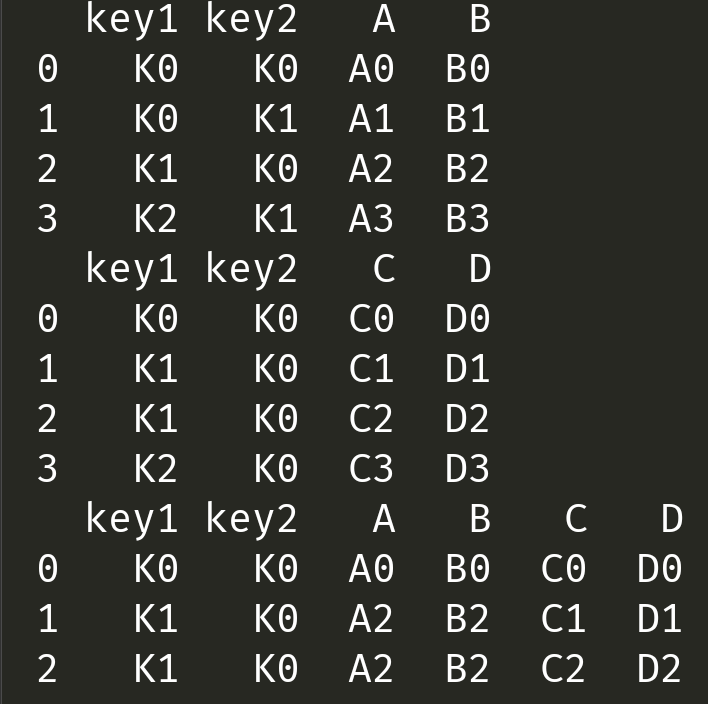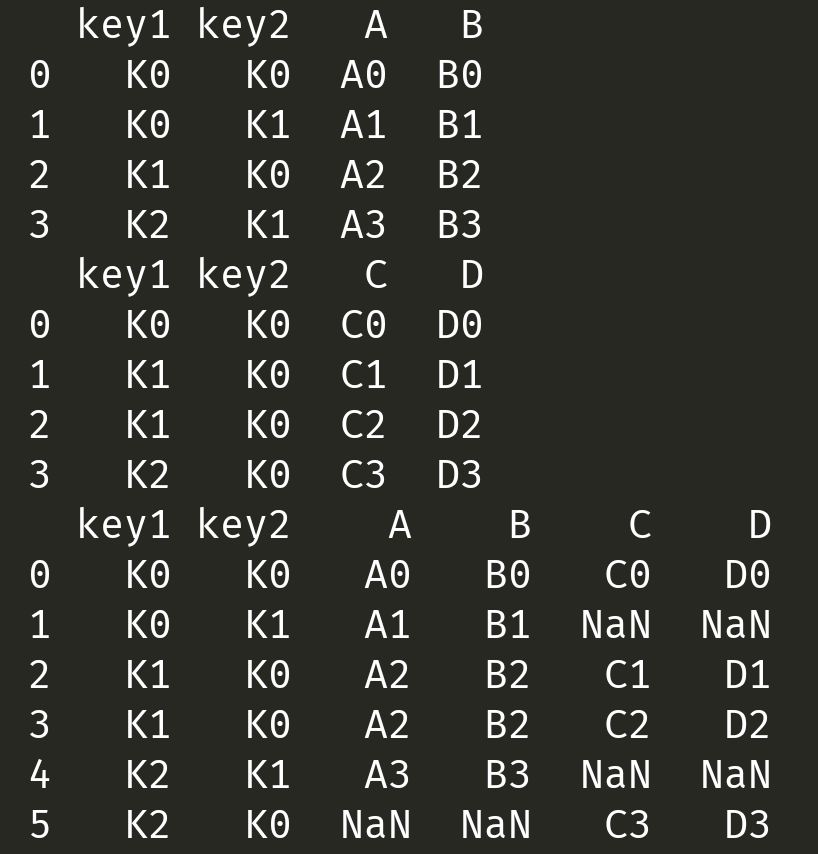1、pd.concat实现数据合并
def concat(objs, axis=0, join='outer', join_axes=None, ignore_index=False, keys=None, levels=None, names=None, verify_integrity=False, sort=None, copy=True): # objs: series,dataframe或者是panel构成的序列lsit # axis: 需要合并的轴,0是行,1是列 df1 = pd.DataFrame({'A': ['A0', 'A1', 'A2', 'A3'], 'B': ['B0', 'B1', 'B2', 'B3'], 'C': ['C0', 'C1', 'C2', 'C3'], 'D': ['D0', 'D1', 'D2', 'D3']}, index=[0, 1, 2, 3]) df2 = pd.DataFrame({'A': ['A4', 'A5', 'A6', 'A7'], 'B': ['B4', 'B5', 'B6', 'B7'], 'C': ['C4', 'C5', 'C6', 'C7'], 'D': ['D4', 'D5', 'D6', 'D7']}, index=[4, 5, 6, 7]) frames = [df1, df2] result = pd.concat(frames,axis=0) print(result) # join:连接的方式 inner,或者outer # inner交集 or outer并集,在并集上原来没有元素的片上用np.nan填充 # keys属性,指定数据来自哪一个分片 result = pd.concat(frames, keys=['x', 'y']) print(result) # 指定具体用哪个分片的index合并 result = pd.concat([df1, df4], axis=1, join_axes=[df1.index])
2、pd.merge
def merge(left, right, how='inner', on=None, left_on=None, right_on=None, left_index=False, right_index=False, sort=True, suffixes=('_x', '_y'), copy=True, indicator=False, validate=None): # left,right:需要merge的DataFrame对象 # how:jion的方式,inner(默认),outer,left(左边对象的key),或者right # on:jion用来对齐的那一列的名字,Columns (names) to join on. Must be found in both the left and right DataFrame objects.
# left_on=None, right_on=None:指定左右键
left = pd.DataFrame({'key1': ['K0', 'K0', 'K1', 'K2'],
'key2': ['K0', 'K1', 'K0', 'K1'],
'A': ['A0', 'A1', 'A2', 'A3'],
'B': ['B0', 'B1', 'B2', 'B3']})
right = pd.DataFrame({'key1': ['K0', 'K1', 'K1', 'K2'],
'key2': ['K0', 'K0', 'K0', 'K0'],
'C': ['C0', 'C1', 'C2', 'C3'],
'D': ['D0', 'D1', 'D2', 'D3']})
2.1、内连接,默认为内连接
# 默认内连接 result = pd.merge(left, right, on=['key1', 'key2']) # 交集

2.2、左连接
result = pd.merge(left, right, how='left', on=['key1', 'key2'])

2.3、右连接
result = pd.merge(left, right, how='right', on=['key1', 'key2'])

2.4、外链接
result = pd.merge(left, right, how='outer', on=['key1', 'key2']) # 并集

3、pd.join
left = pd.DataFrame({'A': ['A0', 'A1', 'A2'],
'B': ['B0', 'B1', 'B2'],
"key":['K0', 'K1', 'K2']})
right = pd.DataFrame({'C': ['C0', 'C2', 'C3'],
'D': ['D0', 'D2', 'D3']},
index=['K0', 'K2', 'K3'])
# 默认内连接
result = left.join(right,on="key")
print(result)
# 等同于如下
result = pd.merge(left, right, left_on='key', right_index=True,how='left', sort=False)
print(result)
详细链接:https://pandas.pydata.org/pandas-docs/stable/user_guide/merging.html